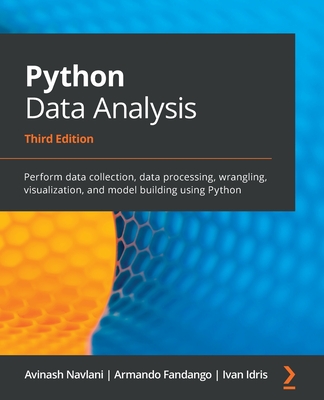Python: Advanced Predictive Analytics: Gain practical insights by exploiting data in your business to build advanced predictive modeling applications
暫譯: Python:進階預測分析:透過利用商業數據獲取實用見解,構建進階預測建模應用程式
Ashish Kumar, Joseph Babcock
- 出版商: Packt Publishing
- 出版日期: 2017-12-26
- 售價: $3,320
- 貴賓價: 9.5 折 $3,154
- 語言: 英文
- 頁數: 660
- 裝訂: Paperback
- ISBN: 1788992369
- ISBN-13: 9781788992367
-
相關分類:
Python
海外代購書籍(需單獨結帳)
相關主題
商品描述
Gain practical insights by exploiting data in your business to build advanced predictive modeling applications
Key Features
- A step-by-step guide to predictive modeling including lots of tips, tricks, and best practices
- Learn how to use popular predictive modeling algorithms such as Linear Regression, Decision Trees, Logistic Regression, and Clustering
- Master open source Python tools to build sophisticated predictive models
Book Description
Social Media and the Internet of Things have resulted in an avalanche of data. Data is powerful but not in its raw form; it needs to be processed and modeled, and Python is one of the most robust tools out there to do so. It has an array of packages for predictive modeling and a suite of IDEs to choose from. Using the Python programming language, analysts can use these sophisticated methods to build scalable analytic applications. This book is your guide to getting started with predictive analytics using Python.
You'll balance both statistical and mathematical concepts, and implement them in Python using libraries such as pandas, scikit-learn, and NumPy. Through case studies and code examples using popular open-source Python libraries, this book illustrates the complete development process for analytic applications. Covering a wide range of algorithms for classification, regression, clustering, as well as cutting-edge techniques such as deep learning, this book illustrates explains how these methods work. You will learn to choose the right approach for your problem and how to develop engaging visualizations to bring to life the insights of predictive modeling.
Finally, you will learn best practices in predictive modeling, as well as the different applications of predictive modeling in the modern world. The course provides you with highly practical content from the following Packt books:
1. Learning Predictive Analytics with Python
2. Mastering Predictive Analytics with Python
What you will learn
- Understand the statistical and mathematical concepts behind predictive analytics algorithms and implement them using Python libraries
- Get to know various methods for importing, cleaning, sub-setting, merging, joining, concatenating, exploring, grouping, and plotting data with pandas and NumPy
- Master the use of Python notebooks for exploratory data analysis and rapid prototyping
- Get to grips with applying regression, classification, clustering, and deep learning algorithms
- Discover advanced methods to analyze structured and unstructured data
- Visualize the performance of models and the insights they produce
- Ensure the robustness of your analytic applications by mastering the best practices of predictive analysis
Table of Contents
- Getting Started with Predictive Modelling
- Data Cleaning
- Data Wrangling
- Statistical Concepts for Predictive Modelling
- Linear Regression with Python
- Logistic Regression with Python
- Clustering with Python
- Trees and Random Forests with Python
- Best Practices for Predictive Modelling
- A List of Links
- From Data to Decisions – Getting Started with Analytic Applications
- Exploratory Data Analysis and Visualization in Python
- Finding Patterns in the Noise – Clustering and Unsupervised Learning
- Connecting the Dots with Models – Regression Methods
- Putting Data in its Place – Classification Methods and Analysis
- Words and Pixels – Working with Unstructured Data
- Learning from the Bottom Up – Deep Networks and Unsupervised Features
- Sharing Models with Prediction Services
- Reporting and Testing – Iterating on Analytic Systems
- Bibliography
商品描述(中文翻譯)
獲取實用見解,利用您的業務數據構建先進的預測建模應用程序
主要特點
- 一步一步的預測建模指南,包括大量提示、技巧和最佳實踐
- 學習如何使用流行的預測建模算法,如線性回歸(Linear Regression)、決策樹(Decision Trees)、邏輯回歸(Logistic Regression)和聚類(Clustering)
- 精通開源的 Python 工具,以構建複雜的預測模型
書籍描述
社交媒體和物聯網(Internet of Things)導致了數據的激增。數據是強大的,但在原始形式下並不具備價值;它需要被處理和建模,而 Python 是實現這一目標的最強大工具之一。它擁有一系列用於預測建模的套件和多種 IDE 可供選擇。使用 Python 編程語言,分析師可以利用這些複雜的方法來構建可擴展的分析應用程序。本書是您開始使用 Python 進行預測分析的指南。
您將平衡統計和數學概念,並使用 pandas、scikit-learn 和 NumPy 等庫在 Python 中實現這些概念。通過使用流行的開源 Python 庫的案例研究和代碼示例,本書說明了分析應用程序的完整開發過程。涵蓋了分類、回歸、聚類等各種算法,以及深度學習等前沿技術,本書解釋了這些方法的運作原理。您將學會為您的問題選擇合適的方法,以及如何開發引人入勝的可視化,以生動呈現預測建模的見解。
最後,您將學習預測建模的最佳實踐,以及預測建模在現代世界中的不同應用。本課程提供來自以下 Packt 書籍的高度實用內容:
1. 使用 Python 學習預測分析
2. 精通使用 Python 的預測分析
您將學到的內容
- 理解預測分析算法背後的統計和數學概念,並使用 Python 庫實現它們
- 熟悉使用 pandas 和 NumPy 進行數據導入、清理、子集、合併、連接、串接、探索、分組和繪圖的各種方法
- 精通使用 Python 筆記本進行探索性數據分析和快速原型設計
- 掌握回歸、分類、聚類和深度學習算法的應用
- 發現分析結構化和非結構化數據的高級方法
- 可視化模型的性能及其產生的見解
- 通過掌握預測分析的最佳實踐,確保您的分析應用程序的穩健性
目錄
1. 預測建模入門
2. 數據清理
3. 數據處理
4. 預測建模的統計概念
5. 使用 Python 的線性回歸
6. 使用 Python 的邏輯回歸
7. 使用 Python 的聚類
8. 使用 Python 的樹和隨機森林
9. 預測建模的最佳實踐
10. 連結列表
11. 從數據到決策 – 分析應用程序入門
12. Python 中的探索性數據分析和可視化
13. 在噪聲中尋找模式 – 聚類和無監督學習
14. 用模型連接點 – 回歸方法
15. 將數據放在正確的位置 – 分類方法和分析
16. 字詞與像素 – 處理非結構化數據
17. 從底部學習 – 深度網絡和無監督特徵
18. 與預測服務共享模型
19. 報告和測試 – 對分析系統進行迭代
20. 參考文獻












